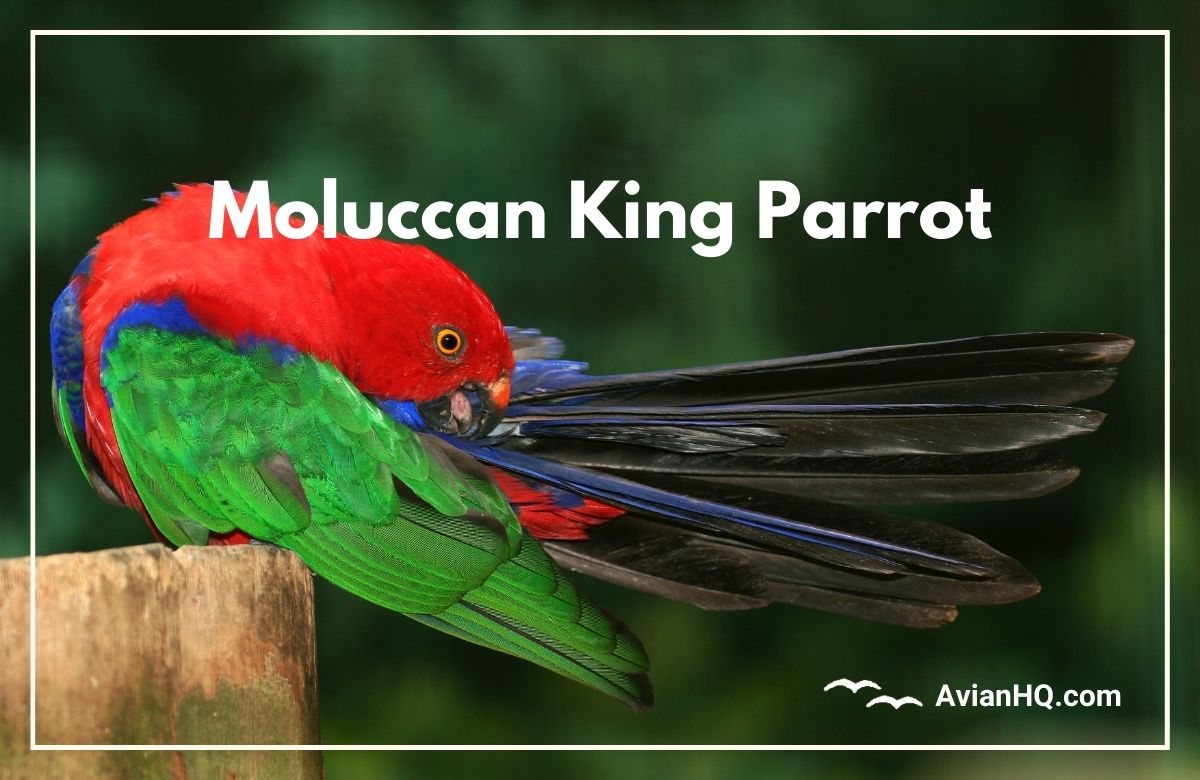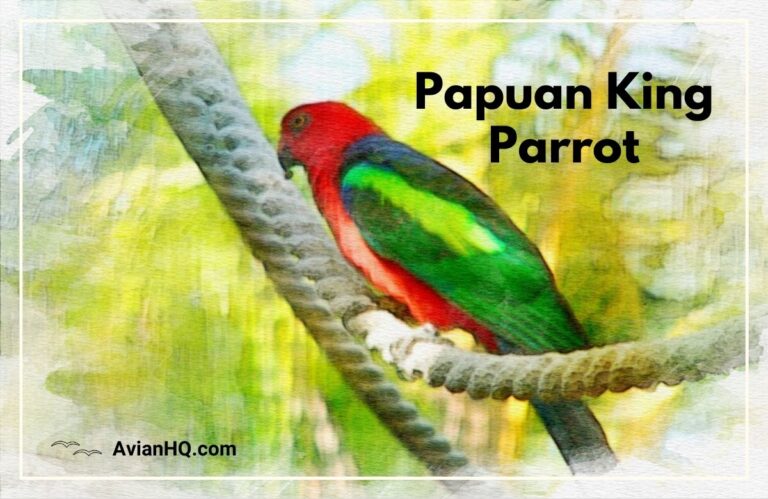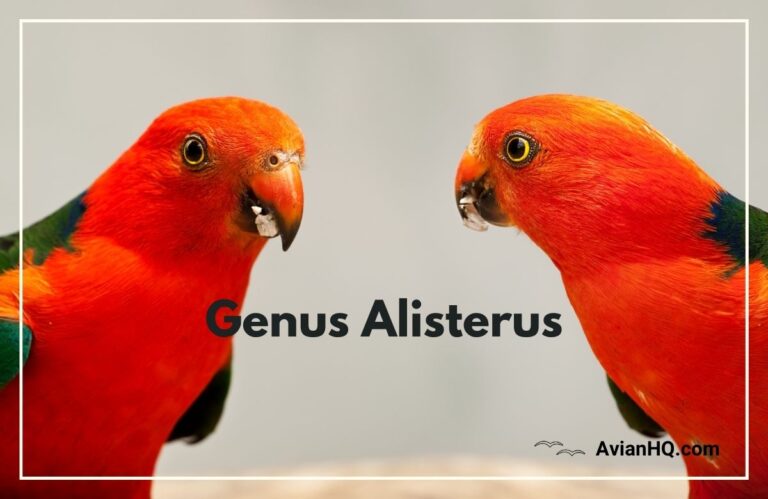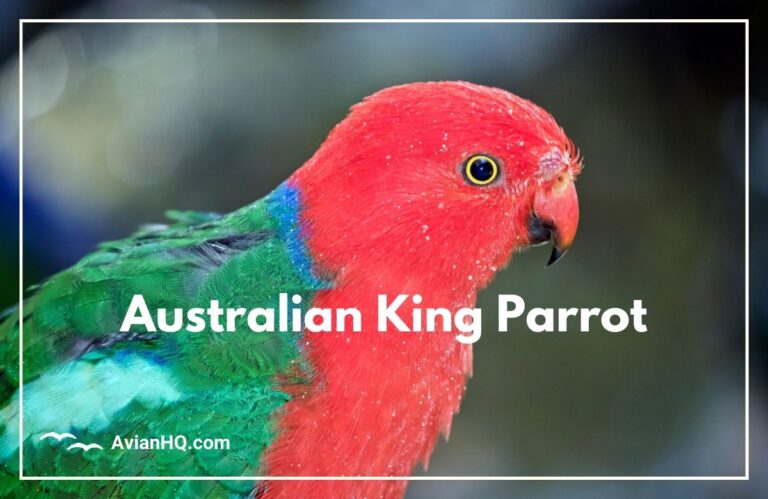Moluccan King Parrot (Alisterus amboinensis)
With it’s brightly colored plumage of red, green, and blue, the Moluccan King Parrot is considered one of the most beautiful parrots in the world. This medium-sized parrot is endemic to the Maluku Islands of Indonesia and parts of New Guinea. Sometimes referred to as the Ambon or Amboina King Parrot, this species has a serene temperament compared to other parrot species.
The Moluccan King Parrot inhabits dense rainforests, where it feeds on various fruits, seeds, berries, and flower buds in the tree canopy. It is generally uncommon in the wild and populations are suspected to be decreasing due to habitat destruction. However, the species has adapted to live in proximity to human settlements.
This parrot has been kept as pets for decades. Their vibrant colors, quiet nature, and ability to mimic make them popular aviary birds. Breeding the Moluccan King Parrot in captivity can be challenging though.
In the wild, this parrot is shy and usually seen alone, in pairs or small groups. It has a distinctive high-pitched call it uses to communicate. The Moluccan King Parrot breeds inside tree hollows and produces 2-3 eggs per clutch.
This species has six recognized subspecies with variations in plumage colors and distribution across different island groups. While not considered globally threatened, habitat loss poses the biggest concern for the future of these island parrots.
In this article, you’ll learn all about the natural history, physical appearance, habitat, diet, breeding behaviors, conservation status and cultural significance of the beautiful Moluccan King Parrot.
History and Taxonomy
The Moluccan King Parrot was first described scientifically in 1760 by French zoologist Mathurin Jacques Brisson, based on a specimen collected on Ambon Island in Indonesia. He gave it the scientific name Psittaca amboinensis coccinea.
In 1766, Swedish naturalist Carl Linnaeus gave the species it’s current binomial name Alisterus amboinensis when he included it in the 12th edition of his Systema Naturae. The genus name Alisterus was later introduced in 1911.
There are six recognized subspecies of the Moluccan King Parrot:
- A. a. amboinensis – Found on Ambon and Seram islands
- A. a. buruensis – Occurs on Buru Island
- A. a. dorsalis – Native to West Papua
- A. a. hypophonius – Endemic to Halmahera Island
- A. a. sulaensis – Occurs on the Sula Islands
- A. a. versicolor – Only on Peleng Island
These subspecies vary slightly in size, plumage colors and geographic range across the Maluku Islands and New Guinea. The nominate race A. a. amboinensis is the most widespread and best known.
The Moluccan King Parrot is closely related to the Australian King Parrot (A. scapularis) and Papuan King Parrot (A. papuensis). All three are sometimes grouped together as “king parrots” due to similarities in appearance and behavior.
Physical Appearance
The Moluccan King Parrot is a medium-sized parrot measuring 13-16 inches (35-40 cm) in length. It typically weighs between 5.1-5.7 ounces (145-163 grams).
The most distinctive feature of this parrot is it’s bright red plumage on the head, neck, throat and chest. The upper back, wings and tail are shades of green and blue. The wings are typically green, while the back and tail range from dark blue to purple-blue.
The tail has a blackish-blue color on top, with some pink edging on the outer feathers in most subspecies. The subspecies A. a. hypophonius is the only one with all blue wings.
The eyes are orange and surrounded by a ring of bare white skin. The legs are dark gray and the curved bill is red and black.
Male and female Moluccan King Parrots have identical external appearance. The only way to determine sex is through DNA testing.
Juveniles have a mostly green plumage, with darker eyes, paler bill, and red tips on some tail feathers. After reaching maturity at one year old, they develop the vibrant adult coloring.
There are subtle variations in size and plumage between the six subspecies. For example, A. a. buruensis has an all black bill, while A. a. dorsalis lacks the pink edging on the tail feathers.
Habitat and Distribution
The Moluccan King Parrot is endemic to the Maluku Islands of Indonesia, also known as the Moluccas. it’s range extends across several island groups including the Sula Islands, Banggai Islands, and Peleng Island.
The western subspecies A. a. dorsalis is found in parts of western New Guinea as well. Overall, this parrot has an island distribution spanning about 1,240 miles (2,000 km).
This species inhabits primary and secondary rainforests, particularly favoring dense, humid forest habitat. It occasionally ventures into nearby gardens, plantations and cultivated areas.
In the wild, the Moluccan King Parrot occurs from sea level up to an elevation of 6,888 feet (2,100 meters). It is most frequently found below 3,900 feet (1,200 meters) elevation.
The species was likely more widespread historically before deforestation reduced it’s habitat. Populations on some islands like Halmahera have declined significantly due to habitat loss.
There are no introduced populations of Moluccan King Parrots outside their native Indonesia/New Guinea range. However, captive bred birds have become popular as pets and aviary birds around the world.
The subspecies have distinct island distributions. For example, A. a. versicolor is confined to Peleng Island, while A. a. hypophonius only occurs on Halmahera Island.
Diet and Feeding
In the wild, the Moluccan King Parrot is an opportunistic, omnivorous feeder. it’s natural diet consists mainly of fruits, seeds, nuts, berries, buds, and some insect prey.
This parrot uses it’s strong bill to open hard-shelled nuts and seeds. Some of the known food items include:
- Fruits: Figs, berries, citrus fruits
- Nuts and seeds: Pecans, almonds, acorns, corn kernels
- Flower buds and nectar
- Insects: Caterpillars, grubs, ants
The Moluccan King Parrot typically forages for food high in the forest canopy but also feeds on the ground at times. It may swallow smaller seeds whole but cracks open hard shells against a perch first.
These parrots feed in the early morning and late afternoon, spending the hottest part of the day roosting quietly. They drink water from tree hollows, bromeliads, and other crevices that collect rainwater.
In captivity, the diet of pet Moluccan Kings should mimic the diversity of their natural diet. A nutritious base mix can be supplemented with nuts, fruits, veggies, sprouts, greens, and some insect matter.
Breeding and Reproduction
The Moluccan King Parrot nests inside tree hollows, with the breeding season lasting from February to March. Not much is known about it’s reproduction in the wild.
Based on observations of captive birds, the clutch size is usually 2-3 white eggs. The eggs are broadly elliptical in shape, measuring approximately 1.3 x 1 inches (33.5 x 26 mm).
The female incubates the eggs for around 19-21 days until hatching. The male helps feed the female during incubation. The chicks are born helpless and with closed eyes.
Both parents share brooding and feeding duties once the chicks hatch. The young fledge at around 9 weeks old, leaving the nest hollow. Juveniles appear similar to adults but have some green plumage still.
Moluccan Kings likely form monogamous pair bonds that may last for multiple breeding seasons. However, the birds do not always mate for life.
Breeding this parrot in captivity can be challenging. The success rate is estimated to be less than 25% even for experienced aviculturists. Proper nesting conditions are essential.
In the wild, the Moluccan King Parrot breeds once yearly. But in captivity, they may potentially produce two clutches in a season if conditions are ideal.
Behavior and Ecology
The Moluccan King Parrot is generally described as a shy, quiet and unobtrusive species. It tends to remain hidden in dense vegetation, avoiding open areas.
These parrots are usually seen alone, in pairs or small groups of 3-4 individuals. Larger congregations may form at prime feeding or roosting sites.
During the day, Moluccan Kings forage quietly and deliberately through the forest canopy. They walk along branches and occasionally hang upside down to reach fruit.
At night, they roost communally inside tree hollows or similar cavities. Groups may emerge at dusk or dawn, calling loudly as they fly to and from the roost site.
Moluccan Kings have several characteristic vocalizations. Their contact calls are high-pitched screeches. They also produce lower-pitched chattering sounds in social situations.
Though shy, these parrots are curious by nature. They may slowly approach an intriguing object while cocking their heads from side to side to gain different perspectives.
There is little information on interactions with other bird species. But Moluccan Kings likely face nest competition for hollows and some predation from tree-climbing mammals.
The typical lifespan in captivity is 30-40 years. In the wild, predation and accidents likely reduce average longevity below 20 years.
Conservation Status
The Moluccan King Parrot is classified as Least Concern on the IUCN Red List of Threatened Species. However, it’s population trend is suspected to be decreasing.
Total wild population size is unknown but likely numbers in the tens of thousands of individuals. The species remains locally common in some areas like the Sula and Banggai Islands.
The major threat is habitat destruction, especially deforestation on small island habitats. Capture for the pet trade poses a secondary threat.
Moluccan Kings are listed on Appendix II of the Convention on International Trade in Endangered Species (CITES), meaning commercial trade requires permits and monitoring.
On islands such as Halmahera, habitat loss has greatly reduced king parrot numbers. Across their range, this species is now absent or rare in disturbed secondary forests.
Conservation efforts involve protecting remaining old-growth rainforest fragments that provide nesting and feeding habitat. Captive breeding for commercial trade is also regulated.
Increased habitat protection and community engagement will be important for the long-term survival of the Moluccan King Parrot in it’s island home. Even small forest reserves can help safeguard populations.
Cultural Significance
The Moluccan King Parrot has long been a part of indigenous culture across it’s range in Indonesia and New Guinea.
This colorful bird features in traditional folklore and creation myths of local peoples, often portrayed as an intelligent messenger or familiar.
For example, on Seram Island, Moluccan Kings are considered intermediaries between the physical and spirit worlds by the indigenous Nuaulu people.
The parrot’s red plumage has symbolic meaning in the Nuaulu culture, representing ritual bloodshed and sacrifice. King parrot feathers are still used in their traditional headdresses.
This species also has a legacy as a pet and aviary bird. Records indicate Moluccan Kings were kept in China during the Ming Dynasty. In Europe, they were a rarity seen only in royal menageries centuries ago.
Today, the Moluccan King Parrot remains a sought-after aviary bird around the world due to it’s beauty, temperament and talking ability. However, capture from the wild is now illegal.
While valued locally as food and pets, most islanders now prefer to see king parrots living free. Ecotourism offers an alternative income through birdwatching tours. Protecting forest habitat provides ecological and cultural benefits.
Conclusion
The Moluccan King Parrot is a stunning tropical parrot restricted to island forests in Indonesia and New Guinea. With it’s bright red, green and blue plumage, it is considered one of the most beautiful parrots in the world.
This medium-sized, shy forest dweller inhabits dense, humid rainforests where it feeds on various seeds, fruits, nuts and insects. The species consists of six subspecies with subtle variations in appearance and range.
Breeding populations of the Moluccan King Parrot are suspected to be declining due to ongoing habitat loss across it’s island home. Capture for the pet trade poses an additional threat.
Conservation efforts focus on protecting remaining old-growth forest fragments and regulating any commercial trade. This magnificent parrot serves as an flagship species for preserving fragile island ecosystems.
Though naturally elusive, the Moluccan King Parrot has adapted well to captivity over centuries, valued for it’s beauty, gentle nature and talking ability. This cultural significance provides additional incentive to safeguard wild populations into the future.




